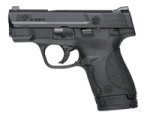By sheer coincidence, I first heard about the tragic death of Veronica Rutledge while I was visiting my step-son, his wife and his three-year old daughter. In fact, little Aliza was sitting right in front of me as I caught a bit of the story out of Hayden, and I couldn’t believe that a child who was even younger than my stepdaughter could have reached into a pocketbook, pulled out a 9mm pistol, somehow got his hand around the grip and shot it off.
My unease with the facts of the story grew greater when I then watched a report from KREM-TV, the station with reporters on the ground in Hayden, which showed a picture of the alleged weapon, which appeared to be a Smith & Wesson Model 3913. The 3913 is a mid-size pistol which, at least in the pic on KREM, shoots double-action only, which means a very long trigger pull. This is not a gun that a two-year old, it seems to me, could very easily (if at all) either hold or shoot. The story simply didn’t seem to fit and it was even more confusing because most of the ‘details’ about the victim’s purse, her training with guns and so forth were actually statements made by her father-in-law, who was nowhere near the Walmart when the tragic shooting occurred.
 On December 31, the Kootenai County Sheriff’s Department issued a formal statement about the shooting and this clarified things for me in one respect but created an even greater sense of unease in another. It turns out that Veronica Rutledge was shot with a Smith & Wesson 9mm pistol, but it was a gun called The Shield, which is one of the smaller and more compact full-caliber guns available to buy. The Shield was designed for the concealed-carry market and with a total length of just 6 inches and an unloaded weight of slightly more than one pound, the gun slips easily into a purse and can be operated without difficulty by someone with small hands. In other words, it’s the perfect gun for a woman who, like Veronica Rutledge, wanted to walk around with a gun.
On December 31, the Kootenai County Sheriff’s Department issued a formal statement about the shooting and this clarified things for me in one respect but created an even greater sense of unease in another. It turns out that Veronica Rutledge was shot with a Smith & Wesson 9mm pistol, but it was a gun called The Shield, which is one of the smaller and more compact full-caliber guns available to buy. The Shield was designed for the concealed-carry market and with a total length of just 6 inches and an unloaded weight of slightly more than one pound, the gun slips easily into a purse and can be operated without difficulty by someone with small hands. In other words, it’s the perfect gun for a woman who, like Veronica Rutledge, wanted to walk around with a gun.
It’s also a gun that could be grabbed and shot by a little kid since the gun’s action, known as striker fire, was specifically developed for use by law enforcement personnel who might need to activate the firing mechanism quickly without disengaging an external safety or being slowed by a long or heavy trigger ‘creep.’ The striker design was developed by Glock and when Smith & Wesson decided to revamp its pistol line to compete with the Austrian gun maker, they outfitted all their police guns with the striker-fired design.
This explains how a very young child might have been able to pick up his mother’s gun and shoot off a round. But the story also has a rather disquieting side because in August, 2013 Smith & Wesson recalled every single Shield pistol manufactured to date. The reason was to fix a flaw in the trigger which could result in the gun discharging if it were dropped. Which means that the gun might discharge with the trigger hardly being pulled.
I don’t know when Veronica Rutledge purchased her Shield or when it was made. But if what I said about the defect was true for her gun, we may not just be talking about a terrible accident. We may be talking about wrongful death. On the other hand, no matter how and why Veronica Rutledge died, the important question isn’t whether the gun worked properly or not. The only real question is why was the gun in her purse? Her family said she was ‘raised’ around guns. That’s not much of a reason to lose your life – it’s really not.
Leave a Reply